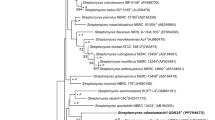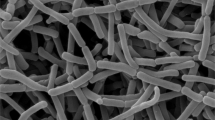Abstract
A Gram-positive, aerobic, non-motile actinomycete (strain MS 3/20T) was isolated from the sediment of the Sundarbans mangrove forest in India. On International Streptomyces Project (ISP) medium 2, the isolate produced yellowish brown to red aerial hyphae that carried spiny-surfaced spores in a retinaculum-apertum arrangement. Whole-cell hydrolysate of the strain contained LL-diaminopimelic acid and galactose. Predominant menaquinones were MK-9(H8) and MK-9(H6). Diagnostic polar lipids were glycolipid, phosphatidylglycerol, phosphatidylethanolamine, phosphatidylcholine, unidentified phospholipid and unidentified amino lipid. The major fatty acids were anteiso-C15:0 (17.53%), iso-C16:0 (23.89%) and anteiso-C17:0 (10.29%). The strain showed 100% 16S ribosomal RNA (rRNA) gene sequence similarity with Streptomyces variabilis NBRC 12825T, Streptomyces erythrogriseus LMG 19406T, Streptomyces griseoincarnatus LMG 19316T and Streptomyces labedae NBRC 15864T. However, strain MS 3/20T could be distinguished from these and seven other closely related species based on low levels of DNA–DNA relatedness (27.2–53.8%), supported by the unique banding pattern obtained from random amplified polymorphic DNA-PCR amplification and the distinctive matrix-assisted laser desorption/ionization–time-of-flight/mass spectrometry (MALDI-TOF/MS) profile of whole-cell proteins acquired for strain MS 3/20T in comparison with its phylogenetic relatives. Disparate morphological, physiological and chemotaxonomic features, principally growth in NaCl, further corroborated the distinction of strain MS 3/20T from other phylogenetic relatives. Strain MS 3/20T is therefore suggested to be a novel species of the genus Streptomyces, for which the name Streptomyces euryhalinus sp. nov. is proposed. The type strain is MS 3/20T (=CICC 11032T=DSM 103378T).
Similar content being viewed by others
Log in or create a free account to read this content
Gain free access to this article, as well as selected content from this journal and more on nature.com
or
References
Sripreechasak, P. et al. Streptomyces siamensis sp. nov., and Streptomyces similanensis sp. nov., isolated from Thai soils. J. Antibiot. 66, 633–640 (2013).
Hong, K. et al. Actinomycetes for marine drug discovery isolated from mangrove soils and plants in China. Mar. Drugs 7, 24–44 (2009).
Xu, J. et al. Streptomyces xiamenensis sp. nov., isolated from mangrove sediment. Int. J. Syst. Evol. Microbiol. 59, 472–476 (2009).
Lozupone, C. A. & Knight, R. Global patterns in bacterial diversity. Proc. Natl Acad. Sci. USA 104, 11436–11440 (2007).
Lee, L. H. et al. Streptomyces pluripotens sp. nov., a bacteriocin-producing streptomycete that inhibits methicillin-resistant Staphylococcus aureus. Int. J. Syst. Evol. Microbiol. 64, 3297–3306 (2014).
Hu, H. et al. Streptomyces qinglanensis sp. nov., isolated from mangrove sediment. Int. J. Syst. Evol. Microbiol. 62, 596–600 (2012).
Sui, J. L. et al. Streptomyces sanyensis sp. nov., isolated from mangrove sediment. Int. J. Syst. Evol. Microbiol. 61, 1632–1637 (2011).
Xiao, J. et al. Streptomyces avicenniae sp. nov., a novel actinomycete isolated from the rhizosphere of the mangrove plant Avicennia mariana. Int. J. Syst. Evol. Microbiol. 59, 2624–2628 (2009).
Arumugam, M. et al. Streptomyces sundarbansensis sp. nov., an actinomycete that produces 2-allyloxyphenol. Int. J. Syst. Evol. Microbiol. 61, 2664–2669 (2011).
Sengupta, S., Pramanik, A., Ghosh, A. & Bhattacharyya, M. Antimicrobial activities of actinomycetes isolated from unexplored regions of Sundarbans mangrove ecosystem. BMC Microbiol. 15, e170 (2015).
Saha, M. et al. Studies on the production and purification of an antimicrobial compound and taxonomy of the producer isolated from the marine environment of the Sundarbans. Appl. Microbiol. Biotechnol. 66, 497–505 (2005).
Shirling, E. B. & Gottlieb, D. Methods for characterization of Streptomyces species. Int. J. Syst. Bacteriol. 16, 313–340 (1966).
Williams, S. T. et al. Numerical classification of Streptomyces and related genera. J. Gen. Microbiol. 129, 1743–1813 (1983).
Gordon, R. E., Barnett, D. A., Handerhan, J. E. & Pang, C. H. N. Nocardiacoeliaca, Nocardia autotrophica, and the Nocardin strain. Int. J. Syst. Bacteriol. 24, 54–63 (1974).
Staneck, J. L. & Roberts, G. D. Simplified approach to identification of aerobic actinomycetes by thin-layer chromatography. Appl. Microbiol. 28, 226–231 (1974).
Ruan, J. S. & Huang, Y. Rapid Identification and Systematics of Actinobacteria 69–116 Science Press, Beijing, China, (2011).
Xu, L. H., Li, W. J., Liu, Z. H. & Jiang, C. L. Actinomycete Systematic-Principle, Methods and Practice 80–87 Science Press, Beijing, China, (2007).
Bligh, E. G. & Dyer, W. J. A rapid method of total lipid extraction and purification. Can. J. Biochem. Physiol. 37, 911–917 (1959).
Card, G. L. Metabolism of phosphatidylglycerol, phosphatidylethanolamine, and cardiolipin of Bacillus stearothermophilus. J. Bacteriol. 114, 1125–1137 (1973).
Tindall, B. J. A comparative study of the lipid composition of Halobacterium saccharovorum from various sources. System Appl. Microbiol. 13, 128–130 (1990).
Miller, L. T. Single derivatization method for routine analysis of bacterial whole-cell fatty acid methyl esters, including hydroxyl acids. J. Clin. Microbiol. 16, 584–586 (1982).
Kuykendall, L. D., Roy, M. A., O’Neill, J. J. & Devine, T. E. Fatty acids, antibiotic resistance, and deoxyribonucleic acid homology groups of Bradyrhizobium japonicum. Int. J. Syst. Bacteriol. 38, 358–361 (1988).
Marmur, J. & Doty, P. Determination of the base composition of deoxyribonucleic acid from its thermal denaturation temperature. J. Mol. Biol. 5, 109–118 (1962).
Rainey, F. A., Ward-Rainey, N., Kroppenstedt, R. M. & Stackebrandt, E. The genus Nocardiopsis represents a phylogenetically coherent taxon and a distinct actinomycete lineage: proposal of Nocardio psaceae fam. nov. Int. J. Syst. Bacteriol. 46, 1088–1092 (1996).
Kim, O. S. et al. Introducing EzTaxon-e: a prokaryotic 16S rRNA gene sequence database with phylotypes that represent uncultured species. Int. J. Syst. Evol. Microbiol. 62, 716–721 (2012).
Thompson, J. D., Higgins, D. G. & Gibson, T. J. CLUSTAL W: improving the sensitivity of progressive multiple sequence alignment through sequence weighting, position-specific gap penalties and weight matrix choice. Nucleic Acids Res. 22, 4673–4680 (1994).
Tamura, K., Stecher, G., Peterson, D., Filipski, A. & Kumar, S. MEGA6: molecular evolutionary genetics analysis version 6.0. Mol. Biol. Evol. 30, 2725–2729 (2013).
Saitou, N. & Nei, M. The neighbor-joining method: a new method for reconstructing phylogenetic trees. Mol. Biol. Evol. 4, 406–425 (1987).
Kimura, M. A simple method for estimating evolutionary rates of base substitutions through comparative studies of nucleotide sequences. J. Mol. Evol. 16, 111–120 (1980).
Felsenstein, J. Confidence limits on phylogenies: an approach using the bootstrap. Evolution 39, 783–791 (1985).
Choudhury, J. D. et al. The pathogen of the Great Barrier Reef sponge Rhopaloeides odorabile is a new strain of Pseudoalteromonas agarivorans containing abundant and diverse virulence-related genes. Mar. Biotechnol. 17, 463–478 (2015).
Lee, J. Y., Jung, H. W. & Hwang, B. K. Streptomyces koyangensis sp. nov., a novel actinomycete that produces 4-phenyl-3-butenoic acid. Int. J. Syst. Evol. Microbiol. 55, 257–262 (2005).
Anderson, A. S. & Wellington, E. M. H. The taxonomy of Streptomyces and related genera. Int. J. Syst. Evol. Microbiol. 51, 797–814 (2001).
Kämpfer, P. & Labeda, D. P. International Committee on Systematics of Prokaryotes; Subcommittee on the taxonomy of the Streptomycetaceae: minutes of the meeting, 25 July 2005, San Francisco, CA, USA. Int. J. Syst. Evol. Microbiol. 56, 5 (2006).
Kim, K. O. et al. Reassessment of the status of Streptomyces setonii and reclassification of Streptomyces fimicarius as a later synonym of Streptomyces setonii and Streptomyces albovinaceus as a later synonym of Streptomyces globisporus based on combined 16S rRNA/gyrB gene sequence analysis. Int. J. Syst. Evol. Microbiol. 62, 2978–2985 (2012).
Kämpfer, P. et al. Streptomyces specialis sp. nov. Int. J. Syst. Evol. Microbiol. 58, 2602–2606 (2008).
Yamamura, H. et al. Streptomyces hokutonensis sp. nov., a novel actinomycete isolated from the strawberry root rhizosphere. J. Antibiot. 67, 465–470 (2014).
Labeda, D. P. et al. Phylogenetic study of the species within the family Streptomycetaceae. Antonie Van Leeuwenhoek 101, 73–104 (2012).
Wayne, L. G. et al. International Committee on Bacterial Systematics. Report of the ad hoc committee on reconciliation of approaches to bacterial systematics. Int. J. Syst. Bacteriol. 37, 463–464 (1987).
Roberts, M. A. & Crawford, D. L. Use of randomly amplified polymorphic DNA as a means of developing genus- and strain-specific Streptomyces DNA probes. Appl. Environ. Microbiol. 66, 2555–2564 (2000).
Murray, P. R. Matrix-assisted laser desorption ionization time-of-flight mass spectrometry: usefulness for taxonomy and epidemiology. Clin. Microbiol. Infect. 16, 1626–1630 (2010).
Tamura, T. et al. Reclassification of Streptomyces caeruleus as a synonym of Actinoalloteichus cyanogriseus and reclassification of Streptomyces spheroides and Streptomyces laceyi as later synonyms of Streptomyces niveus. Int. J. Syst. Evol. Microbiol. 58, 2812–2814 (2008).
Kämpfer, P. in Genus I. Streptomyces Waksman and Henrici 1943, 339 emend. Witt and Stackebrandt 1990, 370 emend. Wellington, Stackebrandt, Sanders, Wolstrup and Jorgensen 1992, 159. Bergey’s Manual of Systematic Bacteriology (ed. Goodfellow M. et al. Vol. 5, 1455–1767 Springer, New York, USA, (2012).
Acknowledgements
This work was supported by the Council of Scientific and Industrial Research through Grant No. 09/096(0717)/2012-EMR-I and the Department of Science and Technology-Promotion of University Research and Scientific Excellence (Phase II) Grant No. DST/SR/PURSE Phase-II/6. We are grateful to the United States Department of Agriculture for the gift of 11 reference Streptomyces strains.
Author information
Authors and Affiliations
Corresponding author
Ethics declarations
Competing interests
The authors declare no conflict of interest.
Additional information
Dedicated to Professor Tuhinadri Sen (31 May 1964–30 November 2016).
Supplementary Information accompanies the paper on The Journal of Antibiotics website
Supplementary information
Rights and permissions
About this article
Cite this article
Biswas, K., Choudhury, J., Mahansaria, R. et al. Streptomyces euryhalinus sp. nov., a new actinomycete isolated from a mangrove forest. J Antibiot 70, 747–753 (2017). https://doi.org/10.1038/ja.2017.3
Received:
Revised:
Accepted:
Published:
Issue date:
DOI: https://doi.org/10.1038/ja.2017.3
This article is cited by
-
Evaluation of antimicrobial activity of the extract of Streptomyces euryhalinus isolated from the Indian Sundarbans
Archives of Microbiology (2022)
-
Polyamine-producing actinobacteria enhance biomass production and seed yield in Salicornia bigelovii
Biology and Fertility of Soils (2020)
-
Antimicrobial potentiality of actinobacteria isolated from two microbiologically unexplored forest ecosystems of Northeast India
BMC Microbiology (2018)
-
Bioprospection of actinobacteria derived from freshwater sediments for their potential to produce antimicrobial compounds
Microbial Cell Factories (2018)



